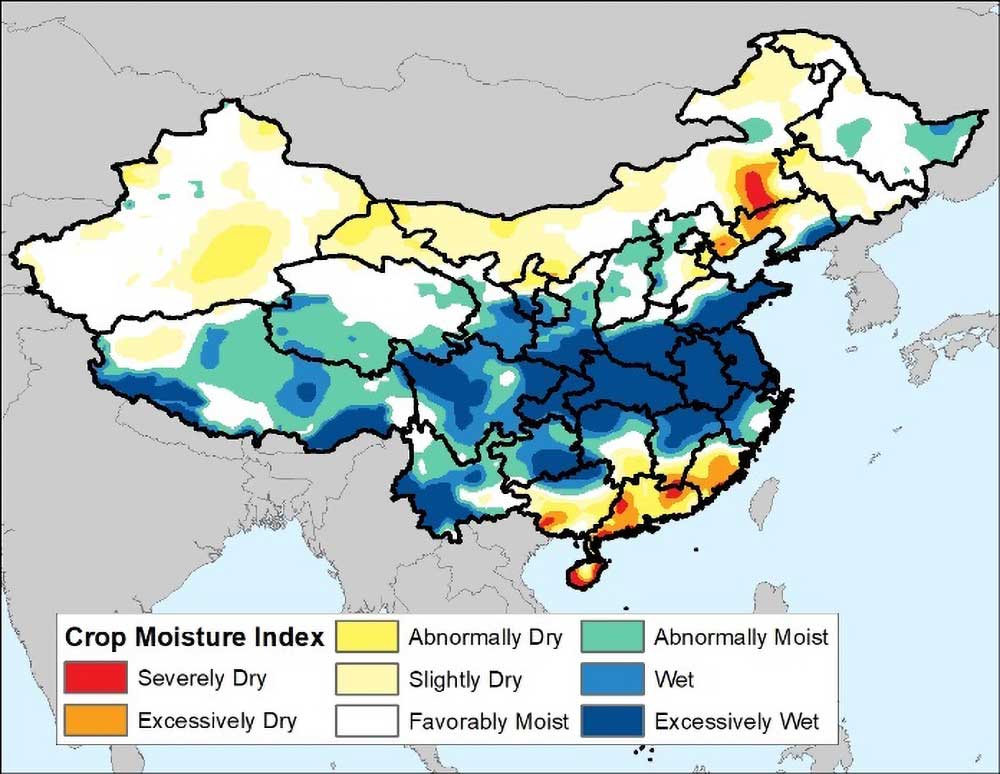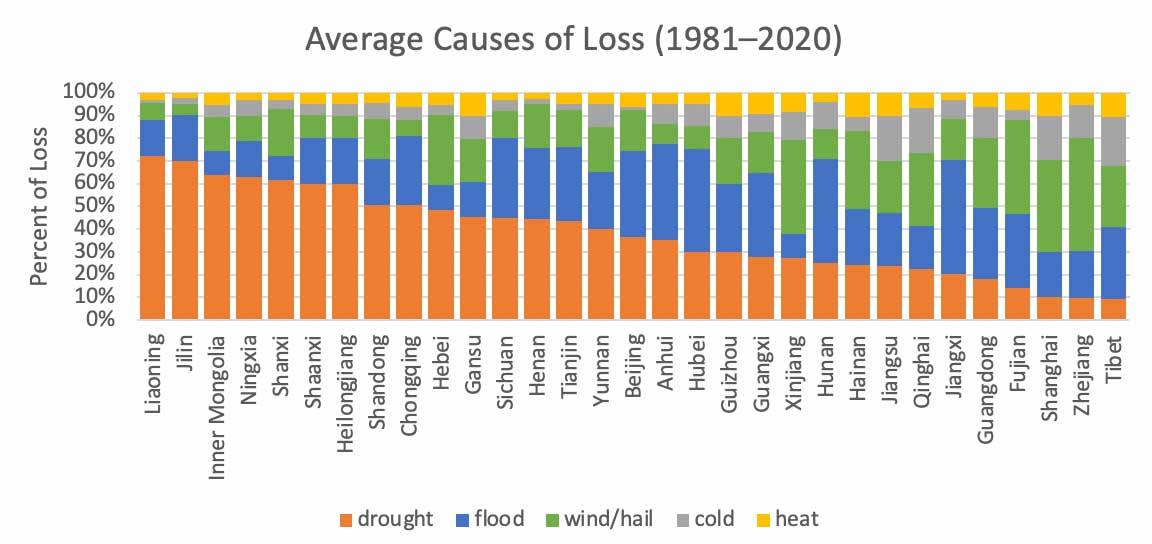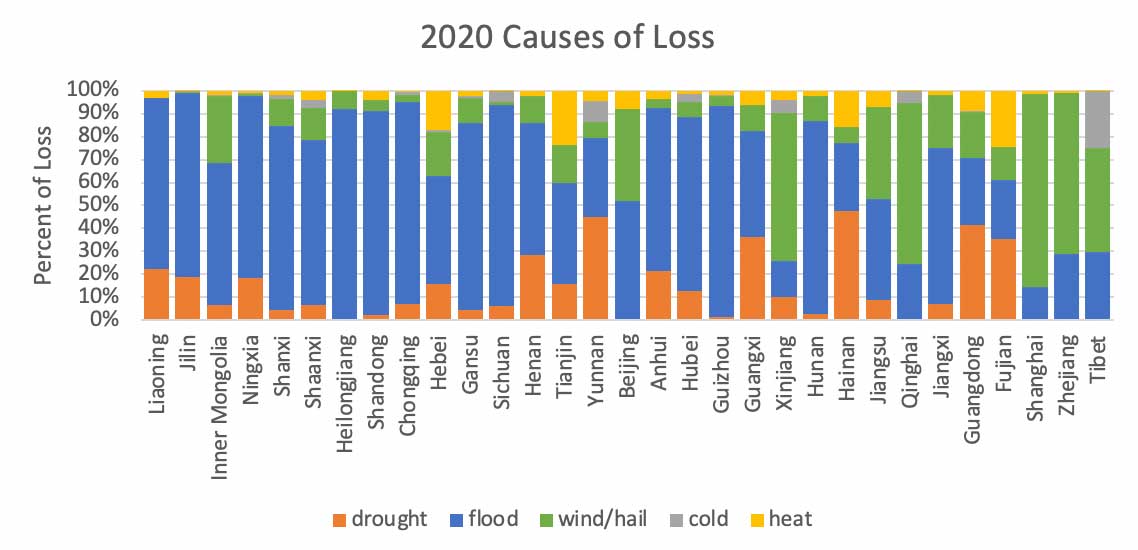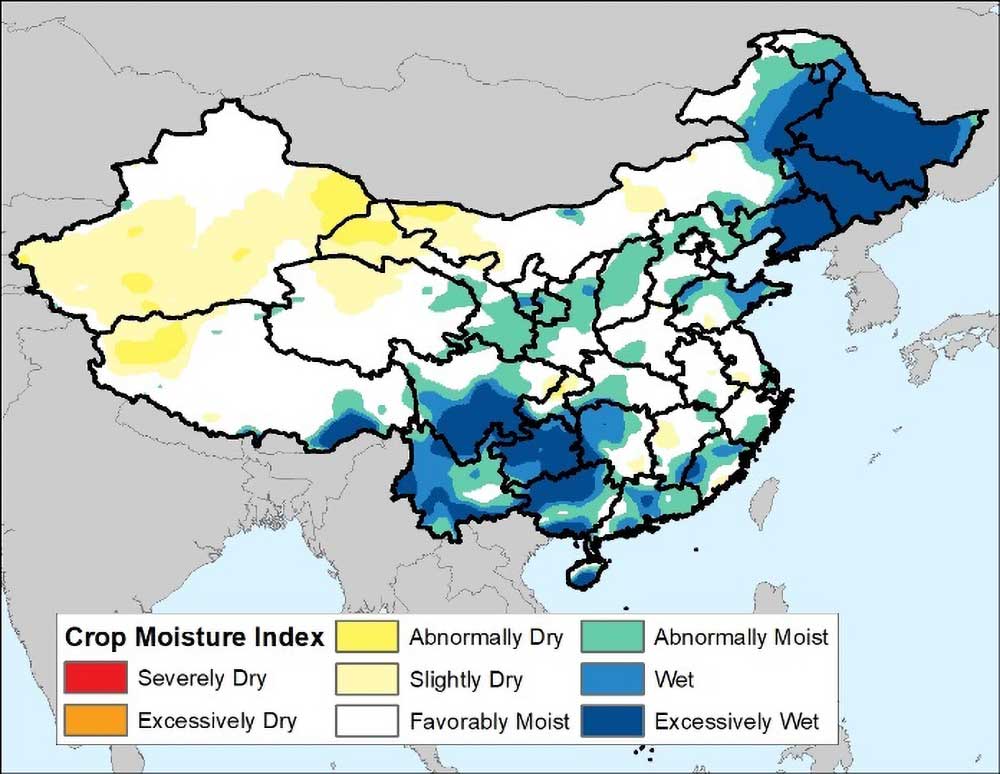China experienced multiple extreme weather events in 2020 that resulted in crop insurance losses, including drought, widespread summer flooding, and typhoons.
Two Extremes in One Summer
Both northern and southern provinces in China experienced drought in 2020, with summer rainfall in these areas totaling 40–90% less than the historical average. Conversely, the middle of the country experienced record-breaking precipitation and flooding over the summer due to successive storms that dumped large amounts of rain over a long period of time (Figure 1). July rainfall in areas along the Yangtze River was 57% higher than the historical average for 1961–2019. According to the China National Commission for Disaster Reduction (NCDR), flooding damaged almost 4 million hectares of cropland in July alone.

Despite governmental flood mitigation efforts, such as the Three Gorges Dam, water levels in the Yangtze River basin exceeded the records set by the devastating floods of 1998, and many lakes and rivers reached or passed warning levels. The excessive moisture across the Yangtze River basin was widespread (Figure 1) and may be related to climate change.
Drivers of Summer Crop Losses
So just how unusual were these events and which ones contributed most to crop insurance losses? The average percentage of AIR modeled losses from 1981 to 2020 attributed to different weather perils for each province is shown in Figure 2. Here we can see that drought is the dominant peril in about one-third of the provinces and the largest contributor to losses in more than half of them. In contrast, the percentage of AIR modeled losses attributed to different modeled perils for 2020 alone shows that flood dominates in two-thirds of the provinces (Figure 3). This is true for provinces within the Yangtze River basin as well as northern provinces that experienced drought in 2020, including Inner Mongolia, Jilin, Liaoning, and Shaanxi. Only the southern provinces that experienced drought saw significant portions of their losses attributable to drought, including Fujian, Hainan, Guangxi, Guangdong, and Yunnan.


Where Did the Drought Losses in Northern China Go?
The relatively minor role that drought played in crop losses in northern China might appear mysterious but can be explained by a closer look at the timing of events that occurred in that region. Two typhoons hit northeastern China in September. Typhoon Maysak made landfall in Jilin on September 3, affecting 340,900 hectares of cropland. Hitting only about one month before the corn harvest, corn lodging (uprooting of the plant, bending of the stalk, or breaking of the stalk, often caused by high winds and rain) may have impacted more than 60% of plants in areas.
Jilin was hit again just days later when Typhoon Haishen made landfall on September 7, bringing heavy rain and wind that affected 110,700 hectares of cropland in Liaoning, Jilin, and Heilongjiang. The excessive moisture these typhoons brought to northeastern China is shown in Figure 4. The typhoon-related impacts in Heilongjiang, Liaoning, and Jilin far outweighed the impact of midsummer drought-stress.

In Inner Mongolia and Shaanxi, farther inland and away from the typhoon impacts, we see other explanations for the distributions of losses. In Inner Mongolia, the relatively large amount of irrigated cropland mitigated the lack of precipitation. In Shaanxi the winter wheat crop was likely harvested around the time of the drought-stress and thus relatively unaffected. The corn crop likely saw some drought impacts, but even those were dwarfed by the impact of multiple heavy rainfall events; the total August rainfall in Shaanxi was the second highest in the period between 1961 and 2019.
AIR Estimates 2020 China Crop Losses
Using the AIR Multiple Peril Crop Insurance Model for China, AIR generated an estimate of the losses to modeled crops by assessing the effects of reported weather in 2019 and 2020. These estimates do not include losses to forestry or livestock. The AIR estimated return period for 2020 crop losses is about nine years, representing the worst year for China crop since the drought-stricken year of 2000 for which AIR estimates a return period of 25 years (note that estimates of losses for historical years use recent policy conditions and recast historical weather, and do not reflect actual past loss experience).
While losses are broad and span many provinces, some crops fared better in 2020 than others. Rice grown across the southern Chinese provinces that were hit by flooding and drought was the most negatively impacted major crop. As discussed above, corn was damaged by typhoon winds and precipitation. Crops that fared well include cotton, which is grown predominantly in Xinjiang and was estimated by the USDA to have record yields in 2020, and winter wheat, which was generally spared the wettest weather (it occurred after the end of the growing season) and the drought and typhoons (areas impacted were north of the main wheat cropping area).
After an eventful 2020, this April has been dry and cool. While expectations for the winter wheat crop are above average, it remains to be seen if the current weather conditions presage a slow start to the summer season or a flip from the recent trend of years dominated by excessive moisture.
Maximize profit potential and make better decisions with AIR agricultural risk models and services




